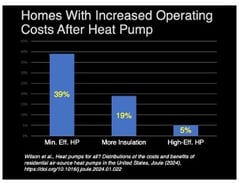 The Inflation Reduction Act provides thousands of dollars in rebates or tax credits for homeowners installing heat pumps. However, even without those rebates, heat pumps would be cost-effective in 65 million U.S. households, according to the National Renewable Energy Laboratory (NREL) research. Further, electrification with heat pumps can reduce greenhouse gas emissions in every U.S. state. However, there is broad variability in the economics of heat pumps after installation, depending on several conditions. Envelope upgrades being one of them.
The Inflation Reduction Act provides thousands of dollars in rebates or tax credits for homeowners installing heat pumps. However, even without those rebates, heat pumps would be cost-effective in 65 million U.S. households, according to the National Renewable Energy Laboratory (NREL) research. Further, electrification with heat pumps can reduce greenhouse gas emissions in every U.S. state. However, there is broad variability in the economics of heat pumps after installation, depending on several conditions. Envelope upgrades being one of them.
An article on NREL’s research is published in the journal Joule. It reports that 39 percent of homes may see an increase in operating costs if a minimum efficiency heat pump is installed. Conversely, if the building envelope is addressed before getting a heat pump, only 19 percent of homes with a minimum efficiency heat pump would see a cost increase. Further, only 5 percent of homes with a high-efficiency heat pump would incur an increase in operating costs after the installation of a heat pump.
Study details
NREL’s study involves air-to-air heat pumps, which deliver heated or cooled air to duct work directly to a room. These are the dominant heat pump types in North America, China, Japan, Australia, and New Zealand, among other regions of the world. (By contracts, air-to-water heat pumps deliver heated water to radiators and are a key solution to replace boilers in countries like Germany and Poland).
The study notes that one shortcoming of the research on air source heat pumps (ASHP) is that the research only considers the “typical” consumer. With so much consumer variability – from climate zone to occupant behavior, housing stock type, and fuel prices, pinning down what is “typical” is impossible. Thus, there may be a wide disparity in average household savings – and some households will experience significant bill increases.
Another problem with cost analysis is the lack of detail in performance modeling. “Some studies use a single coefficient of performance (COP) value to represent efficiency regardless of weather conditions. Several studies improve upon this by using a COP vs. outdoor temperature curve to represent how performance changes with weather. But even this can miss out on other aspects of performance, many of which are particularly important for high-efficiency variable-capacity equipment,” the Joule article notes.
NREL researchers analyzed three different ASHP scenarios with two different envelope upgrade scenarios for six upgrade options. The emission of these upgrade options were evaluated under five different scenarios of how the electric grid might evolve from 2022 – 2038. Consumer economic impact was then assessed on the core scenario with three energy price and three installation sensitivities.

Researchers used the ResStock tool to conduct sub-hourly simulations of 550,000 homes, each representing 242 dwelling units, including single-family and multifamily homes across various climates, housing characteristics, and occupant behaviors. The result was a more detailed picture of how ASHP adoption would affect greenhouse gas emissions and energy bills across 130 million U.S. homes.
The analysis shows that although emissions would be cut (though exact impacts vary by the previous heating fuel type), the cost of energy bills would be highly variable, with negative bill savings for some homeowners and positive energy bill savings for others.
Notably, the study authors note that envelope upgrades (see Table 2, on p. 32 of the article) can save thousands of dollars on the upfront cost of heat pumps. Again, the economic impact of the ASHP on energy bills is widely variable.
The Bottom Line
Even with the wide variability in the impact on energy bills, the study authors note that efficiency is vital. With the global emphasis on cutting emissions, it’s imperative to reiterate the value of envelope insulation upgrades in conjunction with installing heat pumps. NAIMA’s Getting Your Home Heat Pump Ready makes this point and details the urgency of addressing energy efficiency retrofit projects beforehand.
To read the full NREL study details, click here.





